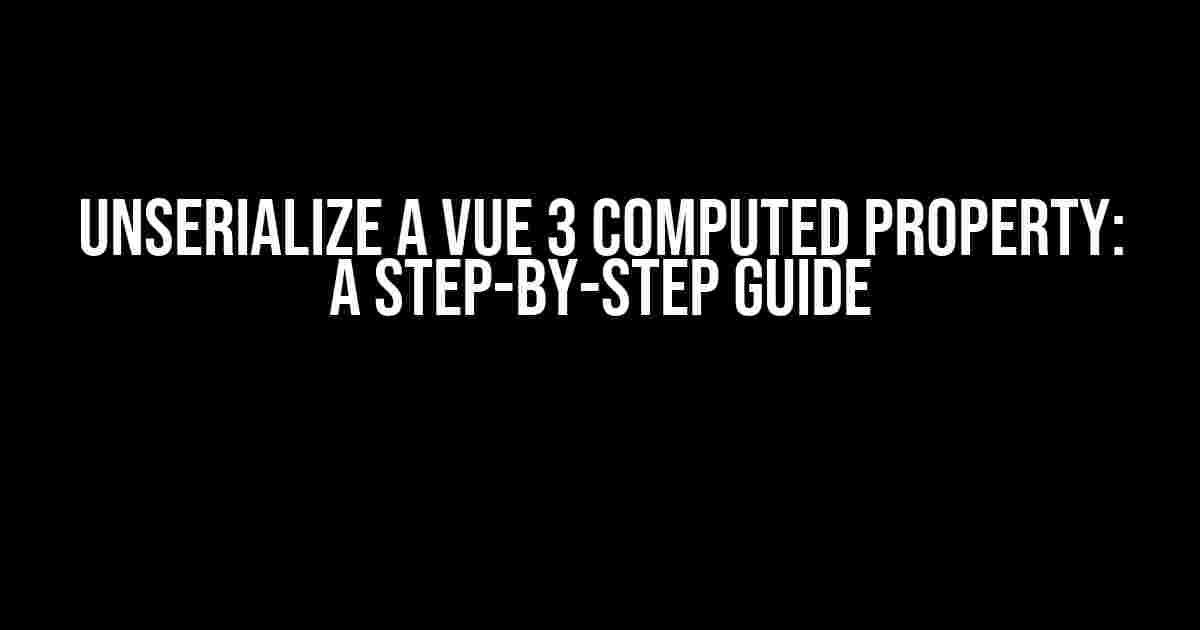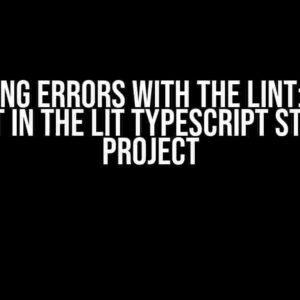Are you tired of dealing with serialized computed properties in Vue 3? Do you want to learn how to unserialize them with ease? Look no further! In this comprehensive guide, we’ll take you by the hand and show you how to unserialize a Vue 3 computed property in a few simple steps.
What is Serialization and Why Do We Need It?
Before we dive into unserialize a Vue 3 computed property, let’s take a step back and understand what serialization is and why we need it. Serialization is the process of converting an object or data structure into a format that can be stored or transmitted across a network connection link. In Vue 3, serialization is used to store computed properties in a way that can be easily retrieved and used later.
But why do we need serialization? Well, without serialization, computed properties would be recalculated every time they’re accessed, which can lead to performance issues and slow down our application. By serializing computed properties, we can store them in memory and retrieve them quickly, making our application more efficient and fast.
The Problem with Serialized Computed Properties
While serialization is useful, it can also create problems. Serialized computed properties can be difficult to work with, especially when we need to access or manipulate their values. This is because serialized properties are stored as strings, which can make it hard to extract specific values or perform operations on them.
Imagine you have a computed property that returns an object with several properties. If you serialize this property, you’ll end up with a string that represents the entire object. But what if you need to access a specific property within that object? That’s where unserializing comes in!
Unserializing a Vue 3 Computed Property
Unserializing a Vue 3 computed property is the process of converting a serialized string back into its original object or data structure. This allows us to access and manipulate the values within the computed property as if it were never serialized in the first place.
So, how do we unserialize a Vue 3 computed property? It’s actually quite simple! Here’s a step-by-step guide to get you started:
Step 1: Identify the Serialized Property
The first step in unserializing a Vue 3 computed property is to identify the property that you want to unserialize. This might seem obvious, but it’s essential to know which property you’re working with to ensure you’re unserializing the correct one.
For example, let’s say you have a Vue 3 component with a computed property called `userDetails` that returns an object with several properties:
<template>
<div>
<p>Name: {{ userDetails.name }}</p>
<p>Age: {{ userDetails.age }}</p>
</div>
</template>
<script>
export default {
computed: {
userDetails() {
return {
name: 'John Doe',
age: 30,
address: '123 Main St'
}
}
}
}
</script>
In this example, the `userDetails` computed property is serialized and stored as a string. To unserialize it, we need to access the serialized string and convert it back into an object.
Step 2: Access the Serialized Property
The next step is to access the serialized property and store it in a variable. You can do this using the `JSON.stringify()` method, which converts an object into a JSON string:
const serializedProperty = JSON.stringify(this.userDetails);
In this example, we’re using `this.userDetails` to access the computed property and `JSON.stringify()` to serialize it into a string.
Step 3: Unserialize the Property
Now that we have the serialized property stored in a variable, we can unserialize it using the `JSON.parse()` method. This method converts a JSON string back into an object:
const unserializedProperty = JSON.parse(serializedProperty);
In this example, we’re using `JSON.parse()` to unserialize the serialized property and store it in a new variable called `unserializedProperty`.
Step 4: Access the Unserialized Property
The final step is to access the unserialized property and use it in your application. You can now access the individual properties within the object using dot notation:
console.log(unserializedProperty.name); // John Doe console.log(unserializedProperty.age); // 30 console.log(unserializedProperty.address); // 123 Main St
In this example, we’re accessing the `name`, `age`, and `address` properties within the unserialized object and logging them to the console.
Best Practices for Unserializing Computed Properties
Now that you know how to unserialize a Vue 3 computed property, here are some best practices to keep in mind:
- Use `JSON.parse()` safely**: When unserializing a computed property, make sure to use `JSON.parse()` safely to avoid errors. You can do this by wrapping the method call in a try-catch block:
try {
const unserializedProperty = JSON.parse(serializedProperty);
} catch (error) {
console.error(error);
}
Conclusion
In this comprehensive guide, we’ve shown you how to unserialize a Vue 3 computed property in four simple steps. By following these steps and best practices, you’ll be able to access and manipulate serialized computed properties with ease.
Remember, unserializing computed properties is an important skill to have in your toolkit, especially when working with complex data structures. With this knowledge, you’ll be able to build faster, more efficient applications that delight your users.
| Step | Description |
|---|---|
| 1 | Identify the serialized property |
| 2 | Access the serialized property |
| 3 | Unserialize the property |
| 4 | Access the unserialized property |
By following these steps, you’ll be able to unserialize any Vue 3 computed property with ease. Happy coding!
Here is the FAQ section about “Unserializing a Vue 3 Computed property” with a creative voice and tone:
Frequently Asked Question
Get the scoop on unserializing Vue 3 computed properties!
Q1: What is serialization and deserialization in Vue 3?
In Vue 3, serialization is the process of converting an object or data structure into a string or buffer that can be stored or transmitted, while deserialization is the reverse process of reconstructing the original data from the serialized form. When it comes to computed properties, serialization is crucial to persist or share the data.
Q2: Why do I need to unserialize a Vue 3 computed property?
You need to unserialize a Vue 3 computed property when you want to retrieve or reuse the data from a serialized form, such as from local storage, a database, or an API response. Without unserializing, the data will remain in its serialized state and won’t be usable in your Vue application.
Q3: How do I unserialize a Vue 3 computed property?
To unserialize a Vue 3 computed property, you can use the `JSON.parse()` method to convert the serialized string back into a JavaScript object. Alternatively, you can use a library like Vue’s built-in `JSON` utility or a third-party library like Lodash to deserialize the data.
Q4: What are the common errors I might face while unserializing a Vue 3 computed property?
Some common errors you might encounter while unserializing a Vue 3 computed property include JSON parsing errors, data type mismatches, or null/undefined values. Make sure to check the serialized data for any syntax errors and handle potential errors gracefully in your deserialization process.
Q5: Can I unserialize a Vue 3 computed property using a Vuex store?
Yes, you can unserialize a Vue 3 computed property using a Vuex store. Vuex provides a built-in mechanism for serializing and deserializing data using plugins like Vuex-persistedstate. This allows you to easily persist and retrieve your computed property data using Vuex’s built-in serialization and deserialization features.





